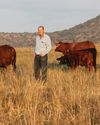Try GOLD - Free
Correct Adaptation Of Livestock On Crop Residues In Winter
Stockfarm
|July 2020
For many livestock farmers crop residues are an indispensable link in their fodder flow programmes, especially in the eastern sourveld areas of the country, where the grazing value of winter veld is very low.

The percentage crude protein of saved winter veld varies between 3,5 and 5,3%, while that of maize residues ranges from 6 to 8,6%.
Digestible organic matter (DOM) of saved winter veld ranges between 50 and 53% and total digestible nutrients (TDN) of maize residues amount to between 60 and 84%.
According to Dr Josef van Wyngaard, technical manager at Voermol, the stocking rate on crop residues will depend on several factors, including plant density and yield, cultivar type, harvesting method and climate factors such as drought.
Adaptation on crop residues
Although crop residues are undoubtedly a valuable and inexpensive winter feed source for livestock, he warns that some potential problems may arise when animals are moved onto fields without having been properly adapted beforehand. This includes:
• Acidosis on grain crop residues due to excess starch.
• Bladder stones on maize crop residues due to excess phosphorus.
• Bloat on legume crop residues due to high levels of soluble protein.
• Prussic acid poisoning when late rains and warm temperatures lead to the regrowth of young shoots.
• Iodine deficiencies on Brassica crop residues (such as cabbage and cauliflower) due to anti-nutritional factors that can impair iodine uptake over a long grazing period.
• A trace mineral as well as vitamin A deficiency.
• Although not common, choking on maize cobs, whole vegetables such as carrots and potatoes, and tubers.
Proper management and lick supplementation can solve all these nutritional problems and deficiencies, and allows for proper utilisation of crop residues as winter grazing.
This story is from the July 2020 edition of Stockfarm.
Subscribe to Magzter GOLD to access thousands of curated premium stories, and 10,000+ magazines and newspapers.
Already a subscriber? Sign In
MORE STORIES FROM Stockfarm

Stockfarm
Ecovite Drifos P12 and P6: Weather resistant phosphate supplements
Over 90% of South African soils are deficient in the mineral phosphorus. The country's warm, dry climate contributes to low levels of organic matter, which in turn limits phosphorus availability to animals.
4 mins
October 2025
Stockfarm
Tick resistance raises concerns
Ticks are the cause of significant annual economic losses, primarily because of the diseases they transmit. In South Africa, the blue tick species is the main culprit.
3 mins
October 2025
Stockfarm
The next generation herd health plan
<span class=
2 mins
October 2025

Stockfarm
When FMD hits: Protocols and practices
South Africa's cattle sector faces tremendous challenges regarding biosecurity and traceability. This year, the dairy industry was among the hardest hit by foot-and-mouth (FMD) disease outbreaks in most provinces in the country, especially the Eastern Cape.
10 mins
October 2025

Stockfarm
Back to basics: Success is built on simplicity and order
We live in an age of constant noise in which we are flooded daily with information and endless decisions.
7 mins
October 2025

Stockfarm
Grassland Society presents 60th congress
The 60th Congress of the Grassland Society of Southern Africa (GSSA) was recently held in Hilton, KwaZulu-Natal, drawing around 160 delegates from across Southern Africa.
3 mins
October 2025

Stockfarm
Livestock's water requirements in intensive and extensive production systems
The Earth's total water supply is estimated at around 1 386 million km³. However, only 2,5% of this comprises freshwater. Of that small fraction, approximately 68,7% is locked away in ice and snow formations in Antarctica, the Arctic, and mountainous regions.
4 mins
October 2025
Stockfarm
Breeding values level the playing field
The production of a dairy cow is influenced by factors such as age, calving season, lactation number and stage, pregnancy status, length of her previous intercalving period (ICP), nutrition, temperature, and management.
3 mins
October 2025

Stockfarm
Boost spring pastures with effective fertilisation
Applying the right nutrients to planted pastures that are tailored to the specific plant species and local environmental conditions, can significantly boost both yield and quality. However, given the high cost of fertilisers, they must be used efficiently to ensure pastures are optimally utilised by livestock. Renier Bothma, a soil scientist at Kynoch Fertilizers, explains that rainfall is a key factor in pasture production under dryland conditions. The more it rains, the greater the pasture growth and the higher the nutrient demand for maintaining optimal yield and quality.
3 mins
October 2025

Stockfarm
WHAT'S UP?
Theft burdens agricultural growth
6 mins
October 2025
Translate
Change font size

